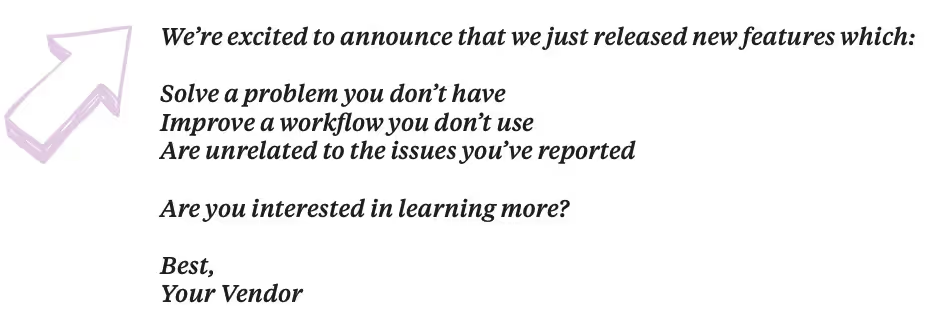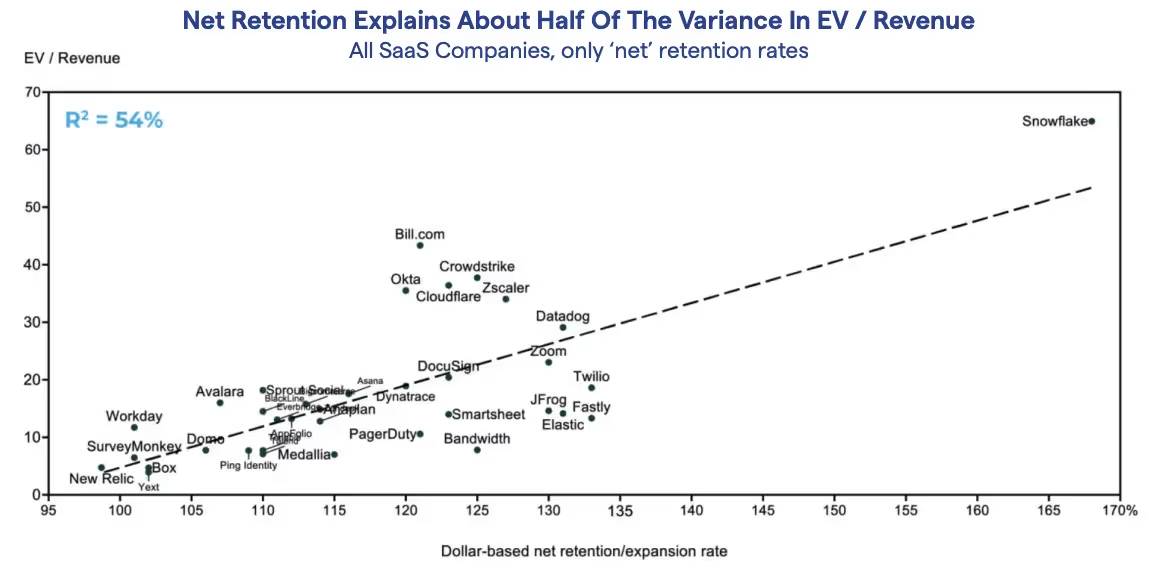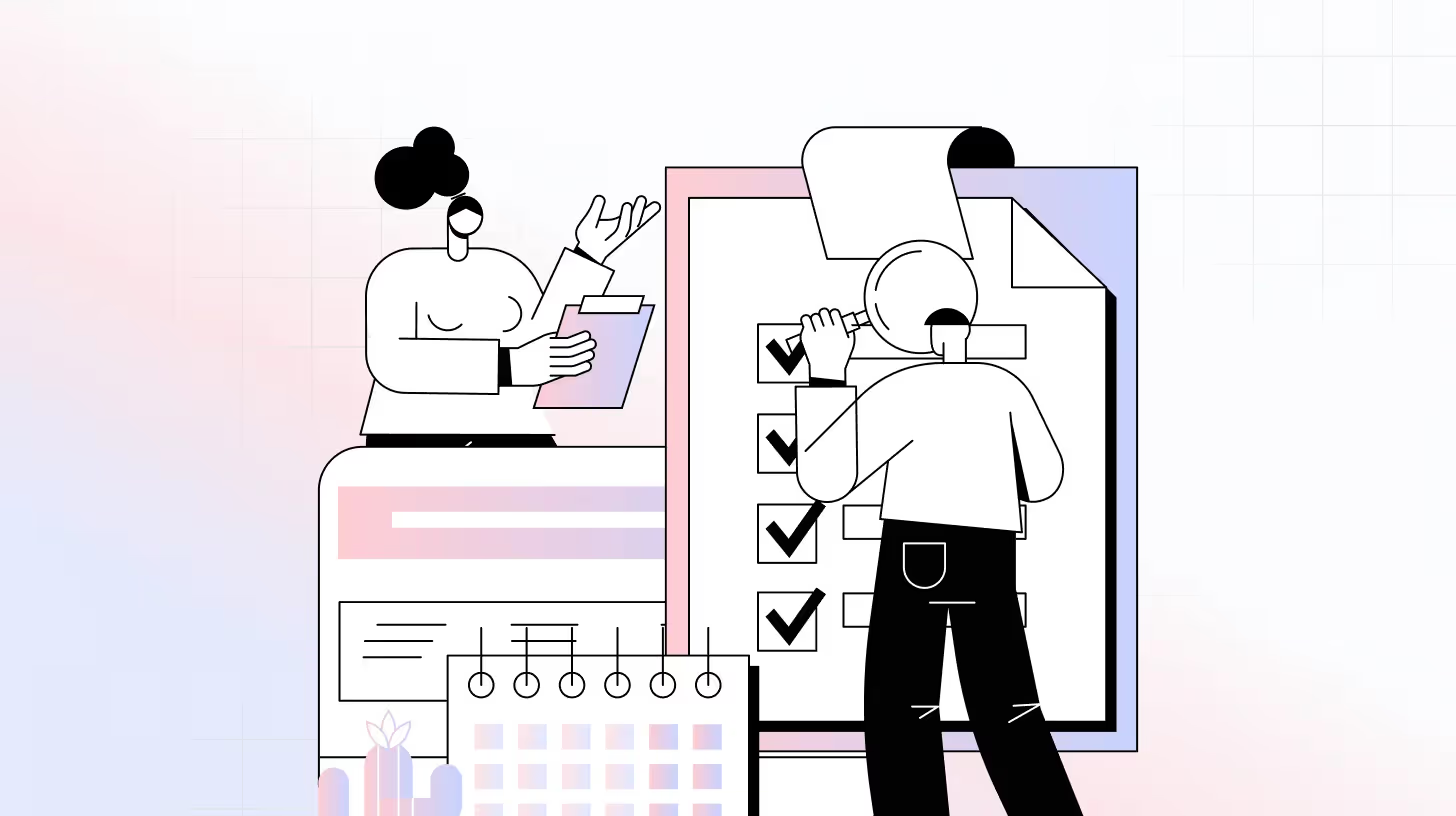 Blog
Blog Why Success Leaders Must Own Upsells and Cross-sells (And How to Do It)
Why Success Leaders Must Own Upsells and Cross-sells (And How to Do It)Why Success Leaders Must Own Upsells and Cross-sells (And How to Do It)

The way we expand accounts today adds very little value to customers. Why? Because Sales still owns the revenue number. In this blog, we explore why upsell and cross-sell customer success should be owned by Success teams, and how this shift can improve outcomes for both customers and companies.
The Problem with Sales-Led Expansion Efforts
How many times have you received an email from a vendor that reads something like this?
We all know why this happens. Your vendor’s Product team releases new features, their Marketing team comes up with snappy language to describe the benefits, and their Sales team applies pressure to let customers know ASAP. Then you as the customer receive a generic “product update” email which is almost always unrelated to your goals and the problems you’ve reported to your CSM. I’d be surprised if you’ve even read one of those emails before sending it to the trash.

The Renewal Meeting No One Wants
What’s worse is the “Renewal Check-in” meeting that gets put on your calendar by your vendor’s Sales team (when I say “Sales”, I’m referring to either Account Executives or Account Managers). You haven’t talked to your Sales rep all year, so they spend an hour asking you questions like:
- How’s your experience been with the product?
- Do you think you’ll need more licenses?
- Do you want to buy any of our new features?
- Can we talk contract terms and timeline?
The whole time you’re thinking, “This is such a waste of time” and you leave the call feeling worse about your vendor than when you joined. Vendors do this to us all the time, and somehow we do the exact same thing to our customers.

Why Sales-Led Growth Fails: A Look at Upselling vs Cross-selling
Customer Success has spent the last decade focusing on onboarding, success plans, QBRs, and influencing the product roadmap in an effort to deliver more value to customers. And yet when it comes to actually turning customer value into expansion, we pass the ball back to Sales and expect them to increase customer spend with very little understanding of the customer’s actual problems and needs.
The result is that Sales teams treat every customer like a nail, and they’re the hammer. They parachute into customer calls, hunt for new dollars, then run to the next deal as soon as possible. And rightfully so. Sales teams aren’t incentivized to deliver more value to customers, their job is to close deals. So by having Sales own expansion, we’re putting pressure on customers to grow even when they’re not getting enough value from their current solution. The hard truth that we have to face as Success leaders is that we’re hurting our customers and our companies by expecting Sales to drive expansion. And it’s our fault.

Why CSMs Are Built for Upsell and Cross-sell Customer Success
I’m always surprised when I hear Success leaders say “My CSMs don’t have the personality to sell”. The reality is that CSMs are motivated to build great relationships and find solutions to customer problems. It’s in their DNA. Those are the exact traits of high-performing Sales people too. The difference is that Sales teams have been trained to ask for dollars, and Success teams haven’t.
Success has focused so heavily on being the “customer advocate” that we’ve lost sight of the fact that upsells and cross-sells actually deliver value to customers. The more value we deliver, the more customers are willing to pay. And that expansion directly impacts our NRR and overall company value.
How Expansion Affects Company Valuation and Customer Retention
Bessemer Ventures did a study that showed that on average every 3% increase in NRR doubles a company’s valuation:

This means that every day Success hands upsells and cross-sells to Sales we’re saying, “Hey CEO and Board, the Sales team is much better at driving company value than we are.” It’s no wonder that Sales teams have more influence, a bigger budget, and get paid more than Success teams. Sales is in the driver’s seat, and Success continues to put them there.
Making CSMs the Quarterbacks of Customer Growth
Now you may be thinking that your Sales team would never let Success own expansions. Frankly, it’s not really their choice. Success is closest to the customer’s needs, which means it’s the only team with enough context to sell value-added products and services that address those needs.
With that said, there is still a critical role for Sales and Professional Services teams to play when growing accounts in a way that adds value to customers. The key is for CSMs to become the actual quarterback of their customer accounts, creating upsell and cross-sell customer success solutions that solve meaningful problems. In order to achieve that, Success leaders need to rethink how CSMs are trained to grow accounts across the customer journey.
How high-performing Success teams upsell and cross-sell
Imagine going to your CEO and saying, “I can double the company’s valuation next year with the team I have today.” That’s a statement every Success leader can make with one simple change–training your CSMs to ask the right questions, to the right contacts, at the right time along the customer journey.

But before starting down this path, it’s critical for your CSMs to understand that by owning account expansion themselves they drastically improve their customers’ experience. Instead of asking your customers to comb through generic product emails or to join prospecting calls with Sales, those customers could work with their main point of contact (the CSM) to solve problems they actually care about. Some solutions can be delivered by the CSM alone, while others require more licenses, product modules, or service add-ons. And other solutions deepen the customer relationship by solving problems for new contacts and teams across the customer’s organization. All paths lead to the same outcome, delivering more value to customers.
The challenge is that your CSMs don’t actually understand your business well enough to grow revenue when they surface an opportunity for upsell or cross-sell. They haven’t been trained to “think like a CEO” and drive all outcomes of an account including value delivery, retention, and expansion. That’s why it’s your job as the Success leader to:
- Create a list of customer problems or use cases that your company’s product and service bundles can solve
- Train each CSM on the different problems a customer may encounter, how various bundles solve those problems, which bundles are most profitable for your company, and when it’s actually the right time to pull in Sales and Professional Services teams
That last part is important. Success owning expansions doesn’t mean that it should be the “everything” function. CSMs should still delegate value-added services like onboarding, training, and executive strategy to ProServ. Similarly, CSMs should delegate upsell and cross-sell “paperwork” (procurement, legal, and security) to the Sales team to ensure terms, pricing, and features are in line with the company's current offerings. The key here is that “delegate” does not mean “abdicate”. CSMs must still be responsible for delivering all customer outcomes, leveraging Sales and ProServ teams as service providers to that end. This keeps CSMs focused on adding value to customers, turning that value into dollars, increasing NRR, and boosting your overall company valuation.
How you structure the exact roles and responsibilities of your expansion teams depends on where your company sits on the maturity curve:

Moving up the maturity curve doesn’t need to happen all at once. You can start by running a small experiment with the very best CSM on your team (the one that just came to mind). First, have that CSM ask these three questions on all of their customer calls:
- What else do you need to solve your current problem (licenses, training, ProServ, etc)?
- What other problems do you have that we can solve?
- What other teams are facing the same issues that you are?
Turn Strategy into Growth with Upsell and Cross-sell Customer Success
Spend an hour a week doing account reviews with your CSM to spot opportunities based on customer responses to these questions. Then work with your Sales and ProServ teams to structure product and service bundles that solve customer problems that surfaced. Have your CSM offer those solutions to customers, and ask your Sales team to handle deal desk activities in the background (they’ll be more than happy to do this since it’ll count toward their quota with very little work on their part).
Conclusion
After 3–6 months, you’ll have enough data to propose to your CEO that Success owns the expansion number—and you’re off to the races. This is your opportunity to transform your customer success strategy from reactive support to a proactive growth engine powered by upsell and cross-sell customer success.
AUTHOR
Nick Paranomos is a Co-founder and COO at ‘nuffsaid. He has over 15 years of experience in strategy, operations, product, and marketing for tech companies.

















.svg)